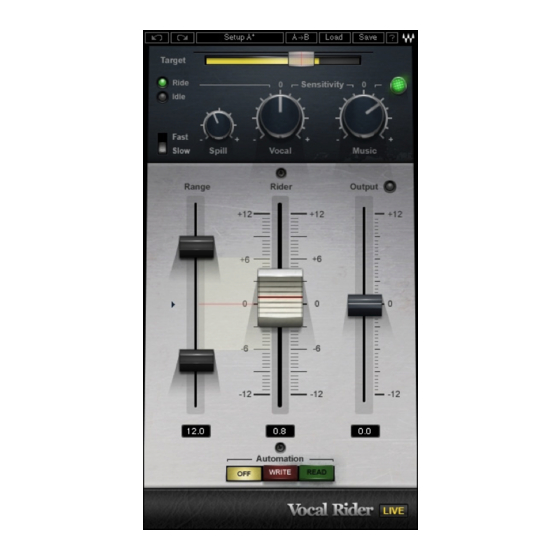
Table of Contents
Advertisement
Quick Links
Advertisement
Table of Contents

Summary of Contents for Waves VOCAL RIDER
- Page 1 Waves VOCAL RIDER User Guide...
-
Page 2: Table Of Contents
Chapter 1 – Introduction ..................3 1.1 Welcome......................3 1.2 Product Overview ..................3 1.3 Concepts and Terminology................4 1.4 Components ....................4 1.5 WaveSystem Toolbar...................4 Chapter 2 – Quickstart Guide ................5 Chapter 3 – Interface and Controls ...............6 3.1 Interface.......................6 3.2 Controls .......................7 Waves Vocal Rider User Guide... -
Page 3: Chapter 1 - Introduction
All you need to do is set the target range of the vocal level in relation to the rest of the mix. Then, Vocal Rider adjusts the level so it stays within your target, raising or lowering the vocal volume, in real-time. And unlike compression, Vocal Rider doesn’t add any additional coloring to your track. -
Page 4: Concepts And Terminology
Vocal gain riding is the final stage, during which the vocal level is fine-tuned by making small changes to its playback level, to make its position in the mix consistent throughout the song. Vocal Rider splits the elements of the mix into two main components: vocals and playback. •... -
Page 5: Chapter 2 - Quickstart Guide
Chapter 2 – Quickstart Guide Insert Vocal Rider as the last plug-in on your vocal or vocal group track. Send your instrumental tracks, post fader, to a bus, just like a headphone mix. Set the sidechain input on Vocal Rider to the instrumental bus. -
Page 6: Chapter 3 - Interface And Controls
Chapter 3 – Interface and Controls 3.1 Interface Waves Vocal Rider User Guide... -
Page 7: Controls
Range: 0 to -42 dBFS Default: -21 SPILL differentiates between vocal signal and unwanted ambient stage noise, to provide better tracking. (Vocal Rider Live components only) Range: -12 to -48 dBFS Default: -48 VOCAL SENSITIVITY controls the vocal detector sensitivity, which differentiates vocal content from noise floor, spill, and ambience, and identifies the beginnings and endings of words. - Page 8 Please note: To use this control, the instrumental mix bus must be assigned to the Vocal Rider side-chain input. MUSIC SENSITIVITY LED indicates when and how much Vocal Rider is affected by instrumental levels. Range: Soft Green to Bright Green When the LED is soft green, vocal riding is less affected by instrumental level;...
- Page 9 IDLE ARROW sets the Rider Fader value when there is no vocal activity. Typically, it is in the middle of the range, to avoid drastic gain changes between words. Range: -12 to +12 Default: 0 Waves Vocal Rider User Guide...
- Page 10 Range: 1 to 24 dB Default: 12 RIDER FADER is Vocal Rider’s automatic control, which moves according to the internal detectors’ algorithm to level-out the vocal, similar to manual fader riding. (The TARGET control is used to set the Rider Fader ‘0’ calibration.)
- Page 11 Though the Rider Fader moves automatically, it is treated by the host application as if automation is being written manually. When set to Read, the Rider Fader uses the automation lane to define its movement, disregarding Vocal Rider’s internal engine. OUTPUT trims the vocal output gain, post-auto riding; the CLIP LED shows when output is clipping.












Need help?
Do you have a question about the VOCAL RIDER and is the answer not in the manual?
Questions and answers